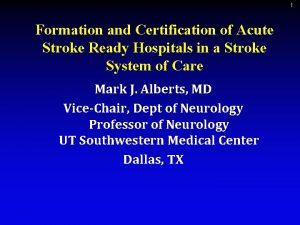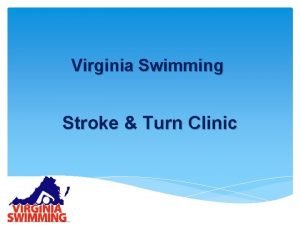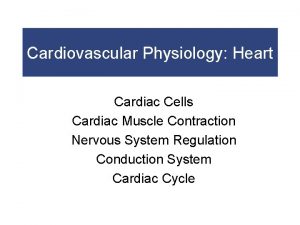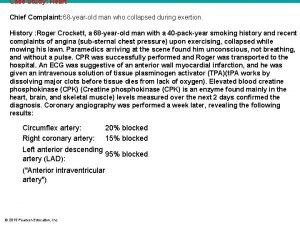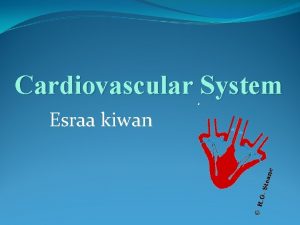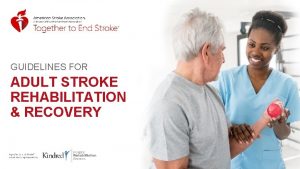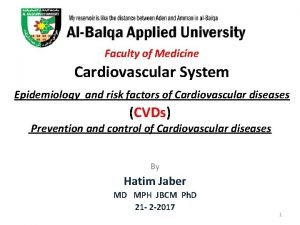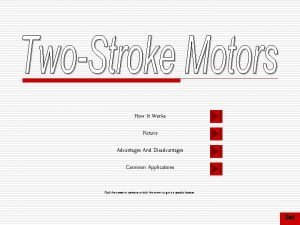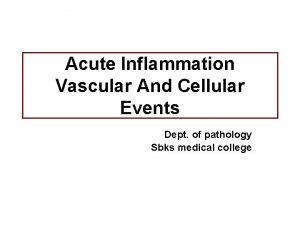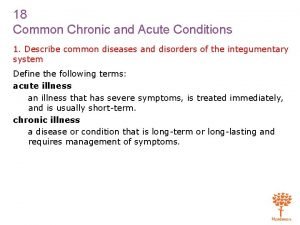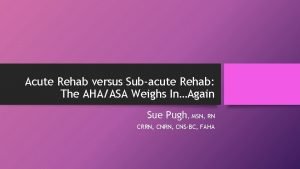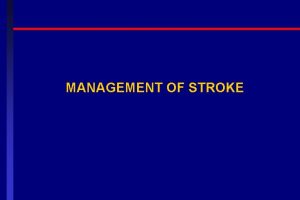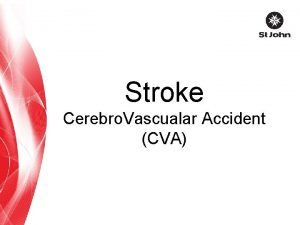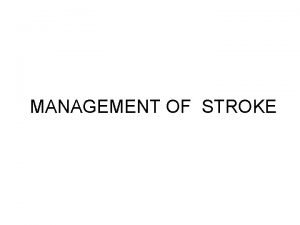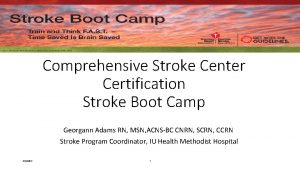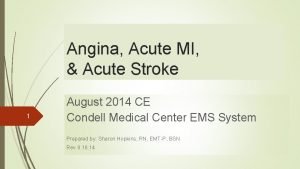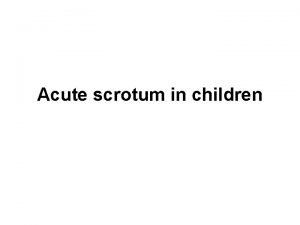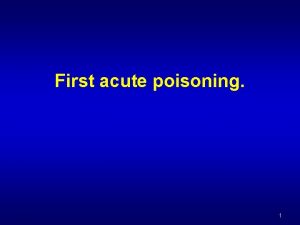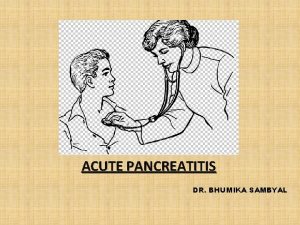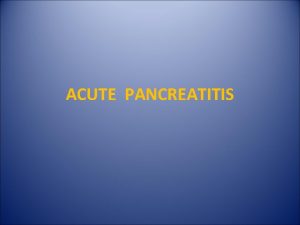1 Formation and Certification of Acute Stroke Ready























- Slides: 23

1 Formation and Certification of Acute Stroke Ready Hospitals in a Stroke System of Care Mark J. Alberts, MD Vice-Chair, Dept of Neurology Professor of Neurology UT Southwestern Medical Center Dallas, TX

2 Presenter Disclosure Information FINANCIAL DISCLOSURE: Speakers Bureau/Consultant: Genentech, Inc. Unpaid Consultant: The Joint Commission, HFAP UNLABELED/UNAPPROVED USES DISCLOSURE: None

3 What is a Stroke System of Care? l l A comprehensive, diverse, longitudinal system that address all aspects of stroke care in an organized and coordinated manner Spans the spectrum of stroke care from primary prevention, calling 9 -1 -1, acute care, secondary prevention, rehabilitation, return to the community As with any system, it is only as strong as its weakest link This talk will focus ASRHs, but all elements are important

4 Pictorial Stroke System of Care Return to the community Primary Prevention/ Secondary Prevention Public Education Rehabilitation Calling 911 Secondary Prevention EMS elements Transportation to hospital Acute Care Stroke Centers

5 EMS Plays a Key Role in a Stroke System l l l Is typically the first medical professionals with direct patient contact Their initial assessments, actions, treatments, and decisions will have significant consequences in the patient’s subsequent care Their role in patient triage, diversion, and routing cannot be under-estimated

6 Medical Impact of Stroke l l l Recent study of 91, 134 patients admitted to 625 hospitals with acute stroke (all Medicare patients) Average = 79 years 58% female 82% Caucasian Overall, 62% of these patients were dead or readmitted after just 1 year Fonarow et al. , Stroke, 2011

Characteristics of Different Stroke Centers Comprehensive Stroke Center Primary Stroke Center Acute Stroke Ready Hospital 7 Academic Medical Center Tertiary Care facility Wide range of hospitals; standard stroke care; stroke unit; use TPA Rural hospitals; basic care; drip and ship; use tele-technologies

8 Numbers of Various Types of Stroke Centers > 5000 total acute care hospitals in the U. S. Comprehensive Stroke Center Primary Stroke Center 150 -220 total Final count 1200 -1300 Acute Stroke Ready Hospital Perhaps 1200 -1800

9 Acute Stroke Ready Hospitals “The New Kid on the Block” l l l Typically small facilities Located remotely away from a PSC or CSC Typically serve small cities or rural populations Stroke population small; likely 1 patient a week on average Limited staffing and bed availability Concept: EMS would take patient to nearest ASRH for: – – 1. initial diagnosis 2. acute stabilization 3. acute treatments 4. then send patient to nearest PSC or CSC

10 ASRH—State Status l l l Many states have developed or are developing their own definitions of ASRH These vary greatly by state and region To date there is no central certifying body or organization Some states have adopted a ‘postcard’ certification process There is a need for uniform criteria and certification

11 ASRHs and Other Hospitals l l l ASRHs would have some type of relationship with one or more CSCs and PSCs Protocols for transfers and referrals Tele-stroke link to another facility Educational programs Transfer agreements (informal) Track transfers and outcomes

12 Key Elements of a ASRH Element Comment Acute Stroke Team At least 2 members; staffed 24/7; at bedside within 15 minutes EMS and ED Care Protocols Able to do rapid brain imaging and lab testing IV TPA protocol Annual training and education 45 minute turn around time Written transfer protocols 60 minute door to needle time To a CSC + PSC Telemedicine link within 20 Procedures set up minutes beforehand

13 Examples of Acute Care at an ASRH Acute Intervention Comment IV TPA 60 minute DTN time Reversal of coagulopathy ICH and SAH patients Treatment of increased ICP ICH, SAH patients Treatment of seizures All patients Blood pressure control Variable depending on clinical scenario

14 Possible Performance Metrics at an ASRH l l l l Evaluation of stroke severity Time to first brain imaging DTN time for IV TPA Time to initiation of anticoagulation reversal therapy Time to initiation of telemedicine link Time to transfer of patient to PSC or CSC Protocol violations

15 Certification Process for ASRH l l l l Formal certification is important to ensure requirements, standards, and performance are met Certification must be done by an outside, independent organization – Self-certification is not acceptable Must include an assessment of facilities, personnel, protocols, and outcomes Must include a site visit Some information submitted on-line ½ day visit every 2 -3 years envisioned Costs = $5000 -$7500 every 2 -3 years

16 Where to Locate these Hospitals? ? Currently 12 PSCs in Iowa; total hospitals = 120 12 PSCs cover 37% of the population 31 PSCs could cover 75% if forced location Or 54 could also cover 75% Who should direct PSC location? ? Need for dialogue and coordination Leira et al. , Stroke, 2012

17 Stroke Care—A System (Network) Approach l l An increasing number of hospitals are forming care networks Maximizing the efficiency of care and resources – Centralize some procedures and facilities – Improving outcomes by increasing volumes – Sharing protocols and expertise l l l Have patient return to their community as soon as feasible Stroke is a particular challenge due to the emergent nature of the disease and time limitations Similar to trauma and trauma centers!!!

18 By-passing Hospitals in a Stroke System of Care With multiple hospitals of various capabilities in a geographic area (or Stroke System), how can we properly triage and divert patients to the most appropriate facility? Guiding Principles # 1 If all are close, go to the highest level Stroke Center initially WHY? – Do not know the type of stroke – Patients can deteriorate – Unclear what tests and treatments will be needed.

19 By-passing Hospitals in a Stroke System of Care Besides the level of Stroke Center, what are other considerations for field triage? Guiding Principle # 2 Time is more important than distance, because time is brain – Factors to consider include: v v Weather Traffic Local geography Mode of transportation

By-passing Hospitals Other considerations—Know Your Hospitals Guiding Principle # 3 To make the best decision, personnel must know the actual capabilities of their local hospitals as well as the EMS system – Not every hospital that claims to be a PSC or CSC will have those capabilities – EMS triage and routing skills may vary by city and region – Bed availability and Who is on diversion – All politics are local!!! 20

21 Challenges with Field Triage of Stroke Patients l l l EMS personnel are correct with field Dx in about 50% of cases There assessment tools for stroke severity Field Dx of ischemic vs hemorrhagic stroke still evolving Pilot studies of head CT in ambulances Patients might still stop at local ASRH to be stabilized before going to CSC or PSC EMS is typically very fragmented and localized – Challenge to get uniform adoption of protocols

22 Conclusions l l ASRHs offer rural access to acute Dx, Rx, and stabilization pending transfer to a PSC or CSC EMS must evolve to meet these challenges Looking to the future, the key challenges of a Stroke System of Care will relate more to EMS triage and diversion THE GOOD NEWS……All of the problems are solvable!!!!! – – – Good will Hard work Common sense

23 DO WHAT IS BEST FOR THE PATIENT!!!
 Acute stroke ready certification
Acute stroke ready certification Anterior stroke vs posterior stroke
Anterior stroke vs posterior stroke Stroke protocol
Stroke protocol Stay ready to keep from getting ready
Stay ready to keep from getting ready Formation initiale vs formation continue
Formation initiale vs formation continue Stroke and turn
Stroke and turn Stab culture and stroke culture
Stab culture and stroke culture Anaerobic medium
Anaerobic medium Simple cardiac cycle flow chart
Simple cardiac cycle flow chart Cardiac output and stroke volume
Cardiac output and stroke volume Co = hr x sv
Co = hr x sv Anaerobic culture method
Anaerobic culture method Describe lawn culture and surface plating
Describe lawn culture and surface plating Guidelines for adult stroke rehabilitation and recovery
Guidelines for adult stroke rehabilitation and recovery Heart disease and stroke are the world's biggest killers
Heart disease and stroke are the world's biggest killers Advantages and disadvantages picture
Advantages and disadvantages picture Acute inflammation definition
Acute inflammation definition Acute obtuse and right triangles
Acute obtuse and right triangles Vascular and cellular events of acute inflammation
Vascular and cellular events of acute inflammation 18 common chronic and acute conditions
18 common chronic and acute conditions Inflammation
Inflammation Acute rehab vs subacute rehab
Acute rehab vs subacute rehab Acute and chronic
Acute and chronic Periradicular tissue definition
Periradicular tissue definition
